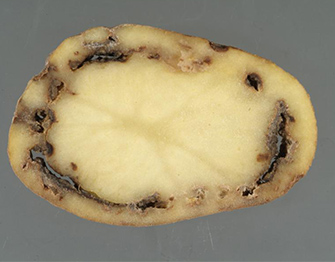Please click here to access the main AHDB website and other sectors.
- Home
- Knowledge library
- Ring rot
Ring rot

Ring rot is caused by the bacterium Clavibacter michiganensis subsp. sepedonicus. The disease is favoured by cooler climates and, already established in northern and Eastern Europe, could readily establish under UK conditions.
Symptom expression occurs at different rates in different cultivars and is affected by temperature and other environmental conditions. Some cultivars may only rarely express symptoms.
Foliar symptoms are fairly typical of a vascular wilt and generally occur late in the season. They usually start as a wilt of the lower leaves which may involve some leaf rolling. Areas between the leaf veins eventually become chlorotic and the leaf margins necrotic. Symptoms can be difficult to distinguish from those of other diseases and other crop damage, symptoms can also be masked by the natural senescence of the crop. Symptoms are much more likely to be observed in tubers. Symptoms are somewhat similar to those of brown rot, but the initial discoloration of the vascular ring is usually glassy and water-soaked rather than brown, and the ooze from the ring is cheese- or cream-like. Further disease development leads to tuber breakdown with internal hollowing. More rarely, in severe cases external symptoms are observed in which the skin of the potato may show slightly sunken, dry and cracked patches and tubers may mummify. Infected tubers may be invaded by secondary pathogens and this leads to complete breakdown.
Symptomless or latently infected seed tubers are the primary source of disease. Some cultivars are partially resistant and may not show symptoms of the disease, particularly during the first year of infection. Infected tubers of some partially resistant varieties may appear healthy and bacteria can multiply during storage. Infected plants, whether or not they display symptoms, are carriers of the disease.
The bacteria can survive in a dessicated state and remain infectious for a number of years on storage materials, equipment etc.. Infection can spread from diseased to healthy tubers by direct contact particularly if the latter are damaged, from contaminated wash water or by contact with contaminated equipment.
In the UK control is through exclusion of the disease. If you see any of the symptoms described above you must immediately contact your local plant health inspector (Animal & Plant Health Agency)

